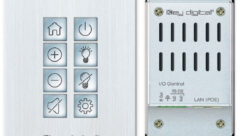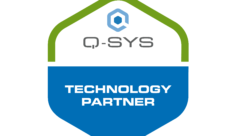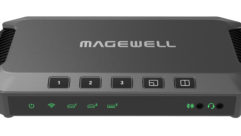QSC Adds Paging to Q-Sys Platform
With the introduction of the PS-1600, PS-800, PS-400 page stations and a suite of supporting software functions, QSC’s Q-Sys audio networking system now addresses the needs of transportation hubs and other facilities needing public address capabilities, company officials said recently.
With the introduction of the PS-1600, PS-800, PS-400 page stations and a suite of supporting software functions, QSC’s Q-Sys audio networking system now addresses the needs of transportation hubs and other facilities needing public address capabilities, company officials said recently.
“The centralized architecture and processing power of Q-Sys allow us to take a different approach,” said QSC marketing vice president Gerry Tschetter, in a statement. “Instead of requiring additional hardware boxes to do paging, all the functions are performed by a Q-Sys core running V2.0 software. All that’s required is the addition of input devices which could be QSC networked page stations, plain old microphones, or a telephone system.”
Three versions of the page station are available and differ only in the number of physical buttons. System designers can select a 16-, eight-, or four-button version depending on the needs of the facility. All versions are offered with either gooseneck or handheld microphones. As with other Q-Sys devices, they support dual networks for redundancy.
The page stations also include a second microphone input so that a single station can serve, for example both the jet-way and the kiosk of an airport departure gate, according to the company. Page stations are connected directly to the Q-Sys core via standard Gigabit Ethernet. They also use Power over Ethernet (PoE) so no local AC power is required.
“Besides paging, Q-Sys page stations can trigger message playback from the Core and even recall snapshots,” said Q-Sys product manager Dale Sandberg, in a statement. “To make each function obvious to the user, we’ve outfitted them with a 240×60 graphics display so instructions can be shown on-screen. To make them robust we’re using capacitive-touch buttons that are very responsive and, since they have no moving parts, extremely durable.”
As part of the Q-Sys software, the Public Address Router handles tasks such as routing pages; delaying, queuing, and sorting delayed pages based on priority and zone availability; playing and routing prerecorded messages; mixing pages and messages with background music; routing background music; receiving telephone-based pages; and more. Other related functions include ANC (Ambient Noise Compensation) and message scheduling.
An administration interface allows facility staff to make changes to zone assignments, priority levels, page commands, passwords, schedulers, and other parameters without getting into the underlying system design. The system designer can determine how much or how little is accessible to the facility staff and can assign password protected access, according to QSC.
Page Stations and V2.0 software will be available beginning in summer of 2010.










